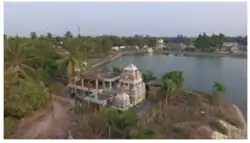Munganda
Munikhanda Agraharam | |
|---|---|
 | |
.svg.png.webp) Munganda Location in Andhra Pradesh, India  Munganda Munganda (India) | |
| Coordinates: 16°35′54″N 81°55′07″E / 16.5982°N 81.9187°E | |
| Country | India |
| State | Andhra Pradesh |
| District | East Godavari district |
| MuniKhanda | 16th century |
| Area | |
| • Total | 5.39 km2 (2.08 sq mi) |
| Population (2011)[1] | |
| • Total | 5,297 |
| • Density | 980/km2 (2,500/sq mi) |
| Languages | |
| • Official | Telugu |
| Time zone | UTC+5:30 (IST) |
Munganda is a village in East Godavari district of the Indian state of Andhra Pradesh. It is located in P.Gannavaram mandal of Amalapuram revenue division.[1] and is part of Konaseema.
History
The village dates back to the early 16th century and is an Agraharam. It is bounded by the Vasishta and Vainateya rivers on the West and Kowsika and Sankhyayana rivers on the East(All these are distributaries of Godavari). There is a tank near the village on the bund of which there were a number of raavi (ficus religiosa) trees. It is believed that sages in the past spent their time in peaceful penance under these trees. Therefore, the place was called Munikhanda Agraharam (place or plot of land of sages). Munganda is a corrupted form of the name. Originally there were three villages Bhanavipuram, Khandrika, and Agraharam which formed part of Peddapuram Samsthanam and which were gifted away to men of learning. Subsequently, they were combined into one village under the name Munganda.
The Agraharam had a major concentration of Telugu Brahmin families belonging to the Vaidiki Veginadu subsect even though the numbers have declined over time due to migration.
"Inti Perlu" (Family names) associated with Veginati Brahmins and Munganda include
Acharyabhatla, Adhikarla, Avadhanula (Upadrasta), Balivada, Bandaru, Bhamidi, Bhattam, Bhyri, Bontha, Bottu, Bussala/Bussarabhatla, Cheemalapati, Chelluri, Cherukuri, Chikka, Dodda, Dusi, Dwadasi, Eswarabhotla, Geddam, Goda, Godavari, Godavarthi, Govindu, Govindavajhula, Gongala, Gudaparthi, Gudimetla, Gurla, Gummuluri, Jaggubhatla, Kamapantula, Kamma, Kammanadiminti (Kamma ane Nadiminti) Kavirayani, Khandavilli, Kodamarthi, Kolanu, Komali, Korada, Kuchi, Maheedhara, Manda, Mandapaka, Mantravadi, Mavileti, Merusomayajula, Mikkili, Mukkamala, Mukku (Upadrasta), Nadiminti, Nemana, Nemani, Pariti, Peketi, Peyyala, Pinninty, Penumarthi, Poola (Upadrasta), Pragada, Pulya, Pulle, Khandrika (Upadrasta), Raghunadhabhatla, Ramapantula, Saraswatula, Simhambhatla, Somavajhala, Somayajula, Sukayogula, Susarla, Tata, Talladwedula, Tetta, Upadrasta, Vahinipathi, Vankayala, Vedanabhatla, Vaduguri, Vulimiri, Vutravadiam, Yellapantula
Scholars and intellectuals
The place has been noted for great intellectuals that had made a name in several branches of Sanskrit learning viz., jyotishya, purana, nyaya, mimamsa, vyakarana, and dharma sastras. Well-known 17th century Sanskrit poet and critic, Upadrasta Jagannatha Panditaraja(1590-1670) had his roots in Munganda.
Nadiminti Rukmeswara Sastry, Nadiminti Sarvamangaleswara Sastry (1759-1839) created four simplified Sanskrit grammar manuals – Sabda Manjari (శబ్ద మంజరి), Samaasa Kusumaavali (సమాస కుసుమావళి), Vibhakti Vilaasamu (విభక్తి విలాసము) and Ramayana Sangraham (రామాయణ సంగ్రహం), which stand as the most sought after textbooks by Sanskrit students even today(https://www.sakshi.com/news/family/nadiminti-sarvamangal-leswara-sastry-telugu-poet-1040188)
Pulya Uma Maheswara Sastry (1887-1959), a Sanskrit grammarian and president awardee lived in Munganda.
Vijayendra Saraswati Swamigal, the 70th Jagadguru of Kanchi Kamakoti Peetam, Kanchipuram belongs to the Mukkamala family of Munganda that migrated to Tandlam Agraharam in Tamil Nadu some centuries ago.
Chelluri Subbarayudu from this village was known to have fought in the army of Jhansi Lakshmi Bai during the First War of Independence 1857.
Geddam Subbarayudu and Kuchi Veerabhadram were celebrated Harikatha and Bhama Kalapam artistes.
Various other individuals of repute associated with Munganda include -
Goda Subrahmanya Sastry(Mimamsa Scholar),
Goda Venkateswara Sastry(Veda Scholar), http://godasastry.in/
Korada Ramachandra Sastri(Author of first original Telugu Drama, Manjarimadhukariam),
Korada Mahadeva Sastri(Indian linguist),
Korada Subbavadhani(ghanapāṭhī and Sanskrit Scholar),
Upadrasta Ramaswamy Sastry (ghanapāṭhī & Somayaji),
Cheemalapati Maridayya Somayaji (Jyotishyam),
Simhambhatla Suryanarayana Siddhanti (Jyotishyam),
Cherukuri Reddy Sastry (Mantra Sastram),
Manda Balarama Sarma (noted flutist),
Susarla Venkata Rama Sastry,
Susarla Surya Bhagavat Sankara Sastry (founder of Visakha Music And Dance Academy (VMDA) Visakhapatnam),
Smt Geddam Somidevamma (ex-Professor Andhra University)
Pinninti Venkatappayya Sastry, Pinninti Mallu Sastry (Tantra Sastram),
Khandavalli Venkata Rama Dikshitulu(Social Service)
Bhamidi Uma Maheswara Avadhani,
Bhamidi Visweswara Sarma alias Tiger (Freedom Movement),
Bhamidi KrishnaAvadhanulu (Sanskrit scholar),
Peketi Chalamavadhanulu & Peketi Ramamurthy Sastry brothers (Sanskrit Scholars),
Peketi Somasekhara Sastry
Mahidhara Jaganmohan Rao (Telugu literature),
Mahidhara Rammohan Rao (Telugu Literature),
Mahidhara Nalinimohan(Indian Space scientist & Telugu writer)
,
Khandavalli Lakshmi Ranjanam and Khandavalli Balendu Sekharam brothers (Telugu Literature)
,
Penumarti Viswanatha Sastry(Known by his pen name "Ajanta". Telugu writer & editor))
,
Godavarthi Bhaskara Rao (Known by his pen name "Ellora". Telugu writer & editor))
,
Mukkamala Bhaskara Narayana (President awardee)
,
Bhattam Srirama Murthy, ex-MLA from Dharmavaram
Nadiminti Siva Swamy, ex-Director, Central Board of Direct Taxes (Nagoor)
Vulimiri Ramalingaswami, ex Director AIIMS, medical scientist, pathologist and medical writer
Contribution to independence movement
The village was always at the forefront during the Khadi movement when hundreds of spinning wheels and handlooms produced both rough and quality khadi during the days of the Swadesi Swarajya movements. Many individuals from this village took an active part in the freedom movement and had been jailed on many occasions.
Temples and worship
The temples of Muleswara Swamy, Rajeswara Swamy, Venugopala Swamy, Mutyalamma, and a Ganapati Mandiram are the places of worship in the village. Ganapathi Navarathrulu is celebrated for nine days from Bhadrapada Suddha Chavithi (August–September). Sahasranamarchanas (repeating a thousand names of the Lord), recitation from Vedas, reading of Puranams and philosophical discussions are held. This festival is being celebrated for the past 120 years but is confined to this place only.
References
- 1 2 3 "District Census Handbook – East Godavari" (PDF). Census of India. The Registrar General & Census Commissioner. pp. 16, 504. Retrieved 7 November 2016.